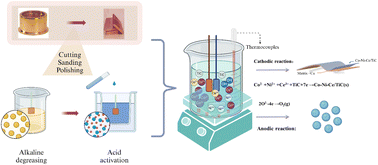Preparation of Co–Ni–Ce/TiC alloy coatings by double-pulse under a sulfamic acid system and a process mechanism study
Abstract
To enhance the protective ability of copper crystallizers and extend their service life, this study explores the use of double pulse co-deposition under a sulfamic acid system to create protective coatings such as Co–Ni. The hardness test and friction wear analysis compare Co–Ni, Co–Ni–Ce, and Co–Ni–Ce/TiC coatings, revealing that the Co–Ni–Ce/TiC coating exhibits the most outstanding protective performance. SEM and XRD techniques are employed to characterize the three protective coatings, demonstrating that the incorporation of rare-earth cerium and nanoparticles improves the coating morphology and modifies their crystalline phase structure. Furthermore, cyclic voltammetry tests on the plating solutions of the three protective coatings indicate that the addition of Ce3+ and nanoparticles influences the deposition potentials. The deposition of Co2+ and Ni2+ follows a two-step, two-electron process, while the deposition of Ce3+ follows a one-step, three-electron process. It is observed that the deposition of all three ions is irreversible. To gain further insights into the nucleation mechanism of Ce3+, a chronoamperometry test is conducted, revealing that the nucleation of Ce3+ is a transient process controlled by diffusion.



 Please wait while we load your content...
Please wait while we load your content...